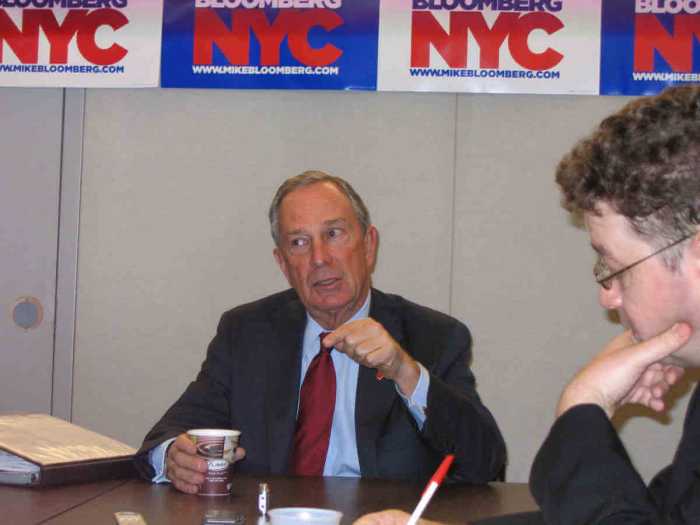Citizens Union’s Rachel Bloom and Democratic State Assemblymember Robert Carroll, who are on opposite sides of the constitutional convention ballot question, at the October 3 Lambda Independent Democrats forum on the issue. | GAY CITY NEWS
If New Yorkers vote for a state constitutional convention on November 7, they could empower the entrenched Albany establishment to make fundamental changes to the state’s founding document. If they oppose a convention, they will be leaving the entrenched Albany establishment in charge of the state government.
What is a voter to do?
“We don’t believe that Albany is working for the people of New York,” said Rachel Bloom, director of public policy and programs at Citizens Union, a government watchdog group, which supports a convention.
Bloom was speaking at an event organized by the Lambda Independent Democrats, an LGBTQ political group in Brooklyn, that was held at the Park Slope United Methodist Church.
Speaking in opposition to the convention was Democrat Robert Carroll, a member of the State Assembly who represents Brooklyn’s Park Slope and Kensington neighborhoods.
Critics of constitutional convention ballot question charge crooks would be in charge
Carroll, who had nothing good to say about Albany during the two-hour event, agreed with Bloom about the condition of the state government.
“I fully agree with you that Albany is broken,” Carroll said during the October 3 event.
Every 20 years, New York voters are asked if they wish to convene a constitutional convention, with its 204 delegates charged with proposing changes to New York’s now 43-page constitution. The question this year has drawn opposition from the left and right, with organized labor leading the opposition.
The opponents include Planned Parenthood Empire State Acts as well as Right To Life, an anti-abortion group, at least a half dozen LGBTQ groups and the state Conservative Party, Democratic and Republican party leaders and groups, and the Council of Churches and the Humanists of Long Island, a secular group. While the groups probably have varying reasons for their opposition, they are all likely doing the same math.
If voters approve of a constitutional convention on November 7, then they will return to the polls in 2018 to elect the delegates. They will elect three delegates from each of the 63 State Senate districts plus 15 at-large delegates.
Currently, the State Senate has 31 Democrats and 31 Republicans in the 63-seat chamber. The 63rd seat will be soon filled by a Democrat. In 2011, the Independent Democratic Caucus (IDC), which currently has eight members, cut a deal with the Republicans that kept them in control of the State Senate.
Assuming the state senators have the organizations that will elect the delegates and so their political views will look like those held by the senator who represents the district and the continued, as some would say, faithless nature of the IDC members, no one can see a path to getting what they want in a convention. Any doubt opponents have about a constitutional convention is firmed up when they look at the current composition of the State Senate.
“People who are ensconced inside of New York’s political class will be the delegates,” Carroll said. “We know what the math is. Numerically, they have the votes.”
The delegates are paid up to $80,000 for their work for one year. They organize their own meeting and decide which changes to propose. Presumably, one year later — but the convention could take longer — the voters approve or disapprove the changes advanced by the convention. In 1967, the last time a constitutional convention met, the delegates offered six changes, but assembled them as a single package for one yes or no vote. The voters rejected the changes.
Proponents believe that regardless of the influence of state senators in electing delegates, they can achieve a reform-focused convention, and they believe the critical needs are to impose ethical and election reforms on a state government that has been mired in corruption, to reform the state courts, to break the stranglehold that the governor and the leaders of the Assembly and Senate have on the Legislature, and to give counties, cities, and towns greater autonomy.
“We are not governed by three men in a room anymore. We are governed by one man,” Bloom said, referring to the power of the governor’s office. “Those are just some of the problems.”
The proponents of a convention include the New York City and State bar associations, Forward March New York, a group that helped organize the January 21 Women’s March on Washington, the State League of Women Voters, and individuals including Jonathan Lippman, the former chief judge of the Court of Appeals, the state’s highest bench, and Roberta Kaplan, board co-chair at Gay Men’s Health Crisis and the attorney who won the late Edie Windsor’s case before the US Supreme Court that struck down the federal Defense of Marriage Act, a 1996 law that barred federal recognition of same-sex marriages.
On the money side, the proponents are outgunned. The opponents have raised more than $700,000 to defeat the proposal to the proponents’ roughly $100,000. And they are certainly outgunned on the organizing. There are 1.9 million union members in New York, and the organizing against the constitutional convention has reached down to the smallest union locals across the state.
The labor groups are organizing under the name New Yorkers Against Corruption (NYAC), a name that is tinged with more than a little irony given that a “No” vote could be seen as at least a tacit defense of the current corrupt state of Albany.
Jordan Marks, the NYAC campaign manager, was not above pointing to Albany as the reason to oppose the convention.
“This culture permeates Albany,” he said. “This culture will permeate this convention. The folks who will hold all the cards are the same folks who run the place now.”






































